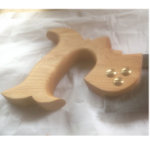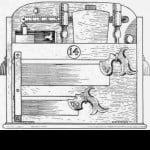Need help with Marking
Welcome! / Forums / General Woodworking Discussions / Tools and Tool Maintenance/Restoration / Need help with Marking
Tagged: marking gauge, mortises, tenons, wheel gauge
- This topic has 12 replies, 7 voices, and was last updated 10 years, 9 months ago by
 David Gill.
David Gill.
-
AuthorPosts
-
 14 July 2013 at 1:27 pm #14750
14 July 2013 at 1:27 pm #14750I have been experiencing a persistent problem using a marking gauge and wonder if any of you could help. The problem is that when I use the marking guage to mark the sides of a mortise in Teak or similar hard wood, the point or cutting tip tends to wander off at times along the grain line. Often I struggle to mark a clean line for mortises as well as sides of tenons. Does the problem have to do with my technique and if so what should I do? Also, some people on the Internet suggest that a wheel marking gauge is better at cutting a clean line on hard woods. Is this true? Any suggestions would be welcome. Thanks.
14 July 2013 at 1:44 pm #14751Hi Indranil,
There are different techniques you can try to remedy this problem. I would suggest orientating the pin on your marking gauge on an angle and trying a light scoring pass. The pin on a marking gauge tends to follow the grain when registered at a perpendicular angle to the surface that you are marking. After doing a light scoring pass at an angle you can gradually increase the angle of the pin to sever the wood fibres deeper as you progress. A wheel marking gauge will help remedy this problem but I find that to achieve a crisp deep marking line, nothing compares to the pin type gauges. Hope this helps.P.S.
Assuming that your pins are straight, sharp and free from damage. 14 July 2013 at 2:09 pm #14754
14 July 2013 at 2:09 pm #14754Thanks very much for your suggestions; will try to do it that way. Also, glad to hear that the pin type gauge is better than a wheel marking gauge, which from what I can gather is much more expensive.
[quote quote=14754]Thanks very much for your suggestions; will try to do it that way. Also, glad to hear that the pin type gauge is better than a wheel marking gauge, which from what I can gather is much more expensive.[/quote]
HaHa, pin type gauges are better than the wheel, only for people that use the pin gauge. 🙂
14 July 2013 at 2:33 pm #14756LOL…My wheel type gauge is here somewhere still in its packaging…I have not seen it for months. It is just a matter of preference…
Marking gauges are frustrating because they are such simple tools but so contrary that they make me feel clumsy. Here are things that seem to help: First is to ignore that you are marking the wood. Focus instead on sideways pressure and make a pass that is so gentle that the pins are touching the wood but not marking it. Then, increase to make the lightest of scratches, then a bit harder, all while focusing on sideways pressure. I do this as practice now but hope in time to drop the multiple practice passes. Also experiment with pulling vs. pushing. I get better results pushing than pulling, although I’ll pull to mark the far corner, drawing towards myself to get that last inch and then push from the near corner to meet that mark.
 14 July 2013 at 3:08 pm #14759
14 July 2013 at 3:08 pm #14759I usually push work piece into some sort of stop like bench dog hold at an angle up to chest if that big.I Then mark on the push stroke going down then stop a couple of inches from end then use a pull stroke up. Do this very lightly once a couple of light passes gone by increase pressure always ensure pushing against your face edge. End grain I do the same but stick work piece in vice. obviously if work piece wide enough for going along grain use vice.

@indranil – These are all good tips. Light first strokes and sidewards pressure especially. Here is one more:
Since the pin will follow the grain, try to make your strokes in a direction where the grain runs away from the edge where your fence rests. As you make the stroke, the pin will try to follow the grain, which will keep the fence tight against the edge, which will then prevent the pin from continuing to follow the grain.
—
@ken – I’ve tried both. I have a veritas double-wheel mortise gauge, and I personally like a (sharp) pin style mortise gauge better. I feel I can more clearly see where the end of my line is when using pins, while the wheel seems to obscure it a bit. Also, the wooden stock of the pin gauges are easier to grip with my large, clumsy hands. Personal preference to be sure. I know that using a pin gauge with dull pins can surely be off-putting. 15 July 2013 at 1:52 am #14784
15 July 2013 at 1:52 am #14784Many thanks for the suggestions. What most seem to agree on is that the problem is not with the gauge but with technique. That’s good to know; for, these days a lot of people seem to emphasise one tool over the other and talk less about the correct use of tools.
Its hard to talk about the correct use of a tool you have never used though eh.
People will emphasise the tool that works for them. Bottom line as long as you are getting the results you want, and you are happy with it, thats the way to go.Good luck with you’re marking gauge. 😉
 15 July 2013 at 9:36 am #14787
15 July 2013 at 9:36 am #14787I also have both and prefer the pin gauges for the deeper mark and the larger stock.
For going across grain I would tend to use a square and marking knife -
AuthorPosts
- You must be logged in to reply to this topic.
